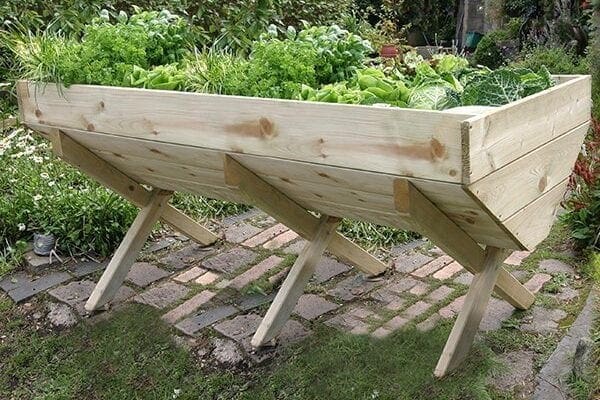Practically any vegetable and soft fruit can be grown in a raised bed.
The popularity of raised beds and deep root planters has surged in recent years. It’s little wonder why, as they boast a series of advantages over growing vegetables in traditional plots.
Practically any vegetable and soft fruit can be grown in a raised bed and most can be cultivated in a planter, so just what are the advantages?
Soil management is one of the most important, most vegetables prefer a pH of around 6.5, however many berries, most notably blueberries and vegetables such as radishes and sweet potatoes, like more acidic conditions.
In an area where alkaline soil is prevalent, ericaceous compost can be used to fill a planter in addition to an organic mulch, and this will lower the pH. Where the soil is too acid, lime can be applied at regular intervals.
Drainage is improved as you are growing above the natural level of the surrounding ground. Sharp sand, grit and similar material can also be easily added to the compost in a planter, or when you are preparing a raised bed, to encourage drainage.
Better drainage will naturally lead to higher soil temperatures and a growing season that starts earlier. The temperature can also be more effectively managed as it is easy to cover a raised bed or planter with fleece or cloche.
Due to the greater depth accommodating their root systems, vegetables do not compete as much and can be grown closer together. This decreases tedious and tiring weeding and increases your crop.
Raised beds can be simply constructed, gravel or scaffolding boards held in place by small corner posts are the most popular but there are many alternatives including railway type sleepers. Bricks and paving slabs can also be used.
The whole bed should be within easy reach so that you don’t have to tread on and compact the soil. So a width of about 4ft is sensible, although this will depend on your reach and mobility. Don’t forget to leave a decent amount of room around the beds to use as paths.
Before filling, the earth beneath the raised bed should be dug and any roots or large stones removed. If you have any turf that has been removed to construct the bed, lay this at the bottom to decompose and then fill with a mix of organic matter (compost and manure) and top soil to the top of the boards. Finally, add a good all purpose fertilizer.
There should be a minimum depth of 12 inches and preferably nearer 20 inches. The soil will settle over time, and this leaves space at the top to apply a mulch.
If any mobility issue or back problems restrict your movement, then a deep root planter is an excellent choice. They are smaller than a raised bed but, as they are higher, demand less bending and are easily accessible from a wheelchair.
Both raised beds and planters should have good drainage but during hot weather you have to make sure that they don’t dry out, and one of the best ways of avoiding this pitfall is an automatic watering system. If you have to use a watering can and you need to maintain an acid soil, rain water collected from a butt is preferable to tap water.
Raised beds and planters can provide solutions to many gardening problems, and with so many well proven advantages their popularity shows no sign of diminishing.
For an extensive range of raised planters and beds, browse online at GardenSite.co.uk





